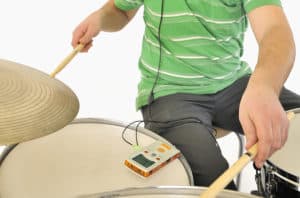
I spent many years of my childhood “practicing” drums but it wasn’t until I started using a metronome correctly that my craft as a drummer really took off. This was so fundamental to me developing my abilities quickly and eventually going to music school, that I thought I would write about it and share some of the lessons that I learned along the way.
So, how do you practice drums with a metronome? The general rule of thumb is to set a slow tempo at first and gradually increase the speed of the metronome as you become more comfortable with what you are trying to play. You can tell if you are playing perfectly with it if you can’t hear the metronome itself as your drum will mask its sound.
That’s the simple answer – but as you can imagine, there is a whole lot more to perfecting the art of practicing with a metronome! Let’s dig into the details a bit more and discuss some tips which you can implement today to improve your drumming tomorrow.
Best Practices for Metronome Practice
As mentioned above, I typically start quite slow when practicing with a metronome (also called a ‘click’, especially in the recording studio) in order to make sure that I am playing the phrase, rudiment or beat I want to learn perfectly. In doing so, I am making sure that I don’t have any technical limitations keeping me from playing the phrase perfectly. This allows me to concentrate on my technique and develop muscle memory for what it is that I am playing.
I cannot emphasize this enough: Starting slow and building up speed over time is absolutely vital to practicing those phrases which you want to perfect.
Many drummers make the mistake of thinking they can just start practicing something at a fast pace in order to gain proficiency. What they find however, is that they aren’t mastering the skill as quickly as they would otherwise, and they are also building and/or reinforcing bad habits and sloppy playing technique! It goes without saying that this is NOT GOOD!
Here are a few steps to help you ensure you are properly increasing your speed while practicing:
- Start Slow: I usually start practicing a phrase or beat about 10-20 BPM (Beats Per Minute) slower than where I start to feel uncomfortable playing the rhythm. Again, this allows me to concentrate on technique, avoid bad habits and build muscle memory.
- Repetition: I will then play the phrase several times in a row at this tempo. A good starting point is 20-30 repetitions for something short like a rudiment or a 2 bar drum beat. You can adjust the number of repetitions based on the length of the phrase.
- Incremental Speed Increase: After that, my ‘go-to’ increment for increasing speed is about 4 BPM. For example, if you are starting your practice session at 60 BPM, play the 20 reps and then bump the speed up to 64 BPM.
- Rinse and repeat!
Volume is Key!
Simply put: drums are loud! Metronomes aren’t (unless they are amplified). In order to be able to practice with one, you should be able to hear it. The trick is really to get the volumes of your playing and the device to match. As such, there are essentially four options for being able to hear a metronome while you’re playing drums:
- Amplify it: Run the metronome through some sort of PA system to make it sound as loud as your drums. (Please wear ear plugs!)
- Headphone it: Wear isolating headphones and plug them into your metronome so that you can hear both equally loud. This option has the extra added bonus of giving you hearing protection, which is vital for any drummer.
- Muffle ’em: Drums don’t necessarily have to be loud. There are all sorts of methods for reducing the volume of your acoustic drums, many of which I have outlined on this blog.
- Electrify ’em: While playing an electronic drum set has its downsides over playing acoustic drums, it definitely has its advantages too. Electronic kits afford you with a quiet playing experience and ability to pump anything into your headphones/speakers along with the sound of your playing. Most of these electronic kits also have metronomes built in, which is definitely a plus.
Whatever option above you end up going with, it’ll probably take some fiddling and experimentation to get it just right. Once you’ve got it though, you can forget the equipment itself and focus on the actual playing. Let’s detail some of the techniques commonly used to maximize your practice session with metronomes.
If You’re Doing It Right, You Won’t Hear It
While you’re not always going to be playing exactly on the beat (see below), it’s very important for you to be able to exactly match the timing of the click so that you build a good command of tempo and technique.
A cool trick to ensure you’re matching the tempo exactly is to make sure the volume of the metronome matches your current volume of playing and then…listen for it! If you can’t hear it – you’re on it. By matching the timing exactly, the sound of your own drums will mesh with the sound of the metronome exactly and give you the illusion that the click is now off!
Play Ahead and Behind The Beat
Many drummers naturally play ahead of or behind the beat. It’s human nature for everyone to have slightly different interpretations of where the beat is. To complicate matters, many different styles of music require you to play slightly ahead or behind the beat.
In other words, you aren’t always going to play EXACTLY on the beat every time, which is why it’s important for you to be able to control how you’re playing in relation to the beat.
An example of this is found in musical styles like funk and reggae, where you are consistently playing behind the beat just a bit.
Top Tip: To make this a bit more fun, it can be a good idea to pretend that the metronome is actually a band member you’re playing with! There are some metronomes like this one, which allow you to not just set a click, but actually interact with different parts of the beat and even a human voice!
Don’t Forget The Drum Fills
Many drummers have no problem playing a beat along with a metronome. It gets tricky with drum fills though, as this is an area where beginners typically lose their sync with the click track. I have definitely been there before. There is that dreaded moment as you’re playing a familiar beat where your mental clarity takes a nose dive and the drum fill takes on a life of its own.
To avoid this, make sure that you are not only practicing a specific beat or drum fill by themselves, but playing them together repetitively. You can use the exact same method described in this article.
In doing so, you will learn how the beat and fill flow together and even if you play a different beat the next time, the flow into the fill will still come naturally because you’ve repeated the pattern a few dozen times during metronome practice.
Record Yourself And Listen To It
In the middle of an intense practice session, it can be extremely difficult (and misleading) to really hear yourself in relation to the click track/metronome. Your brain can play tricks on you while you are playing. It can seem as though you are absolutely nailing a passage or phrase when in reality…it’s not quite sounding like you’re hearing it in the moment.
Because of this phenomena, I highly recommend that you record yourself during practice and then go listen back to that recording immediately after playing it. In doing so, you will immediately be able to recognize how you are playing something and go back to fix it in the next set of repetitions.
Be forewarned though, it can be easy to get discouraged with this method of practice because audio recordings of yourself don’t lie and expose every flaw for you to scrutinize. It is highly effective though and can result in really fast improvements in your playing overall.
Related Questions
Are there metronome apps or software? Yes. Lots! There are many options especially for mobile apps on all platforms, including some good free ones. Because there are so many options, I won’t make any specific recommendations here but it’s best to go off of app store reviews to choose the best one.
Can a metronome help you sleep? While there is no clear answer here, some research suggests that the use of a metronome can help you re-arrange your sleep patterns. There are even products like this one on the market which use a combination of a metronome and light to accomplish this goal.
on the market which use a combination of a metronome and light to accomplish this goal.
